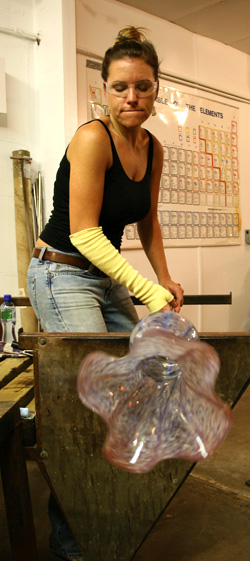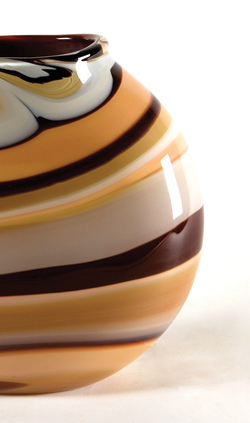Nothing fires up this central Illinois native like hot, molten glass.
You may have admired her work at the Peoria Riverfront Market, or bumped into her at an event catered by Echo Valley Meats. Perhaps you’ve bid on one of her vases at an auction, or purchased a trademark glass pumpkin at the Morton Pumpkin Festival. Since returning to central Illinois in 2007, Jeremie Draper has worked hard to establish herself in the local arts community, all the while educating the public on her beloved art of glass.
Pallet of Exploration
Drawn to art at an early age, Draper remembers experiencing the creative rush as far back as first grade. “I had a whole pallet of crayons in front of me, and I started exploring,” she recalls. “I used just about every single crayon… That’s what really sparked my love of color.”
Growing up, the Pekin native’s explorations never stopped. Her mother and both grandmothers had her sewing as a child, and in high school, she dabbled in just about every artistic medium—drawing and painting, photography and ceramics, metals and woodworking. “Anything that was bendable or had texture, I was morphing into something.” In college, her needlework background segued into a natural curiosity with fibers—working with sheep hair and natural materials like tree bark, palm leaves, walnuts and goldenrod for dyeing.
Fittingly, a class on color theory at Illinois Central College made a pivotal impact on the budding artist. One exercise in particular—to reproduce a specific shade of color, working backwards from a broad pallet—especially piqued her interest. “It’s easy to mix a lot of colors together,” she notes, “but to be able to extract the colors to make a certain shade was intriguing to me.”
Inspired by the impact of color on the human psyche, she conceived and constructed installations that placed viewers in a single-colored room to observe the emotions a given color would elicit. One involved a room painted bright-orange, with orange curtains, an orange rocking chair and even an orange man, quietly reading a book. “We dyed his clothes and painted his body. He was reading a book drenched in orange paint. And we asked people how it made them feel.” True to its typecast, the orange room drew intense reactions: “Some people were anxious, some were excited and wanted to interact, and some left really quickly—they didn’t like it.”
A second installation of “cool” colors from the color wheel—blues, purples and greens—offered a palpable counterpoint. “Some people felt it was too calm, even boring; others appreciated the serenity. It triggered feelings of lying out in the grass, watching the stars as a young child,” she says. “I was getting all of these different cognitive memories from people, just by putting color in front of them. It was fascinating.”

An Odyssey in Glass
After ICC, Draper headed to Southern Illinois University in Carbondale, initially as a zoology major. Soon, however, the school’s nationally recognized art program grabbed her attention. “Seeing all the visual 2D and 3D arts that Southern had to offer, I knew that was my calling,” she remembers. After first choosing the fibers program, she found a completely different medium beckoning her.
“I had to walk past the glass studio every day,” she explains, “and I’d never seen molten glass before. I got bit by the bug!”
Under the guidance of renowned glass artist Che Rhodes, Draper immersed herself in the history of glassmaking, from the early processes of the Romans and Egyptians to the refinements of the Venetians, whose classic techniques are still widely used today. After taking classes in flat glass and learning the basic techniques of fusing (applying heat to join pieces of glass together) and slumping (using a mold to form the glass into its shape), she moved on to glassblowing and more advanced techniques, such as murrine making, where colored rods of liquid glass, called canes, are cooled and sliced cross-wise to reveal intricate, layered patterns of color.
Her time at SIU culminated in a very unique BFA thesis project. “I was graduating in glass,” Draper recalls, “but I really wanted to show off my fiber work, too.” An idea came to her on a study-abroad trip to France, where she was struck by the sense of movement she perceived billowing through some of the marble sculptures. “All this gorgeous, hard marble was captured in a flowing way. The gowns looked like they were moving. And I thought, how can I capture this movement? When I came back [to the States], I headed to the drawing board.”
Pulling together all her experience across a variety of mediums, she designed nine pieces of women’s apparel over the course of her senior year, each comprised of glass and hand-dyed silk, some held together by handcrafted metal fasteners. Premiering her work at a glass fashion show in New York, the initial reaction, according to her professor, was an awestruck, hushed silence from the audience. The consummation of her training as an artist, she brought the collection to the Contemporary Art Center of Peoria in 2004—her first solo exhibition.
Pay It Forward
Upon graduating, Draper took off to Oregon, where she became involved with a growing community of glass blowers. “That was my first ‘real-world’ experience,” she explains. As primary assistant at a studio in Portland, “I was able to see how glass blowers were ‘making it’… and got to work with people from all different glass backgrounds.”
After several years in the Pacific Northwest and a brief stint in Colorado, she returned to central Illinois and landed a seasonal position at Echo Valley Meats, assisting co-owners Dave and Dawn Alwan over the busy holiday season. The arrangement worked so well that she was offered a full-time position as their catering and events coordinator, which Draper at first declined.
“I said, ‘Thanks, but no thanks’… I need to touch glass—that’s my passion,” she remembers. The next morning, she was startled to discover how far the Alwans would go to bring her on board. “I came into work, and [Dave] had a pile of [paperwork]—all this glass equipment he found on eBay and Craigslist that people were selling. And he said to me, ‘Haven’t you ever wanted your own business? What about your own studio?… Let’s find some equipment and build you a studio here.’
“I thought, ‘This is too good to be true,’” she laughs. But it was no joke, and after six years of “doing the starving artist thing,” not only did she have a steady paycheck, she had her own studio as well. There was just one catch:
“[Dave] said, ‘I see how driven you are, and I want to do this for you, but in return, when you see someone in need and have an opportunity to help, I want you to help them,’” Draper recalls. The Alwans helped her locate the equipment and obtain a business loan, and they built a studio, conveniently adjacent to Echo Valley’s Bartonville office. Just over five years later, the catering business is thriving, the studio is paid off, and Draper, through her work with various nonprofit groups, has never forgotten her commitment to “pay it forward.”
 Function Over Concept
Function Over Concept
In contrast to her rather conceptual line of glass apparel, the majority of Draper’s current work is more functional. “I encourage people to pick up my work,” she says. “I want them to understand they can use it… develop a relationship and conversation around it, so it doesn’t just sit in their china cabinet.”
That was the inspiration behind her wine sets and line of home décor, which features everyday objects like bottle pourers, tumblers, vases, dish soap cruets, rondelles, platters and oil lamps. “I want a comfortable piece of art that can spark a conversation,” she says, “whether it’s the wine glass you’re drinking out of, or a little bud vase you just put flowers in.”
She describes her landscape collection as “a little more conceptual, though they’re also functional.” The striped bands of color that characterize this collection were inspired by the layers of sedimentary rock she admired through her travels as a teenager in the American Southwest. Likewise, the brilliantly colored bowls and vases in her Italian collection are both artistic and utilitarian, created using the cane and murrine techniques she learned in school.
Draper is also well known for her line of glass pumpkins, which are not functional at all—“just fun to make.” Six or seven years ago, she set up a small table at the Morton Pumpkin Festival, “and within two hours, I sold every single one of them,” she remembers. “I couldn’t believe the response!” And that’s why “you’ll always find me at the Pumpkin Festival on my [September] birthday!”
Art at Sea
Already well-established locally, Jeremie Draper’s passion for glass will soon be going international. She recently returned from the Corning Museum of Glass in New York, where she worked with a team of artists to prepare for the museum’s “Blow Glass at Sea” program. In 2014, she will spend three months aboard Celebrity Cruises, blowing glass for guests as part of the cruise line’s entertainment services. It’s an amazing opportunity to travel the world and connect with other glass artists, all under the auspices of the preeminent museum in her field.
Back in central Illinois, Draper plans to focus on her line of home décor, “and try to establish myself in boutiques and even bigger stores.” With several ideas for site-specific installations up her sleeve—including a tribute to her grandmother at Hooked on Fishing—she hopes to do more expansive work as well. In the meantime, through her classes and demonstrations, she will continue to spread the word about her beloved hot glass, ever exploring, just like the young girl with the box of crayons… a&s
Jeremie Draper’s art can be viewed by appointment in her Bartonville studio, 608 W. Garfield Ave. Her work will be on display at the Pekin Public Library in June, and she’ll be at the Peoria Riverfront Market every Saturday morning throughout the summer. Class schedules are available at echovalleyglass.com; group demonstrations are offered, and birthday and corporate parties are welcome. Call (309) 339-6244 or visit echovalleyglass.com.


